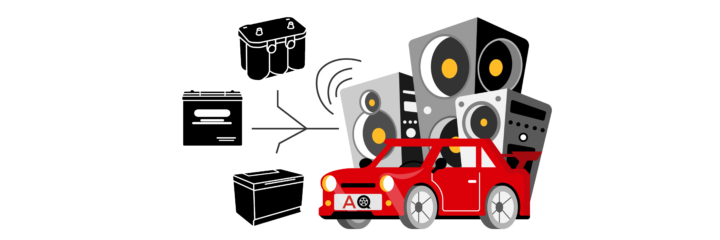Whether you are just a music enthusiast looking for the cleanest sound or want to rattle entire blocks with your bass, chances are you upgraded the sound system in your car (or are about to, in which case you should read our guide to the best amplifiers and car speakers, too). Factory sound systems are, after all, usually lacking in performance.
The problem is that a factory electrical system isn’t meant to handle the increased power that a big amplifier demands. The good news is that you can upgrade or add a battery to make it all work out. In this guide, we’ll help you choose the best battery for your sound system.
We’ll quickly touch on the different specs and reasons you’d want an upgrade, and we’ve compiled a list of the ten best solutions for you and our reviews of each. After that, we also have some in-depth information that can help you continue to upgrade your car’s sound system.
- A Quick Look at Audio Batteries
- Top 10 Best Car Audio Batteries 2025
- 1. Best Overall Audio Battery: XS Power D3400
- 2. Best Budget Audio Battery: Kinetik Black Power Cell
- 3. Most Durable Car Audio Battery: Optima 8014-045 Yellow Top
- 4. Best Entry Level Audio Battery: Mighty Max Battery Viper
- 5. Best Premium Audio Battery: Limitless Cyber 12K Lithium
- 6. Best Small Audio Battery: XS Power XP750
- 7. Longest Lasting Audio Battery: Odyssey 34R-PC1500
- 8. Best Compact Lithium Audio Battery: MMG YTZ14S
- 9. Best Secondary Audio Battery: Stinger SPP1200
- 10. Best Audio Battery Alternative: Pyle 5.0 Farad Digital Power Capacitor
- All About Audio Batteries
- Crank the Volume
A Quick Look at Audio Batteries
There are many batteries for cars on the market, but there are only a handful that are especially suited for use in-car audio. That’s a good thing; it makes it easy to narrow down the right product for you. The first thing you have to ask yourself, though, is whether you need a battery at all.
Do You Need More Power?
Most simple sound systems, infotainment systems, and other accessories don’t put much of a load on your car’s electrical system. The power needed to start an engine and keep it running is relatively high, and a small radio doesn’t compare. However, if you have any of the following symptoms, the answer is probably yes.
- Your sound system exceeds 750w
- Your lights dim when the bass hits or when you power on the amp
- Your windows don’t roll up as quickly as they did prior to installing the system
- You notice a lot of corrosion and buildup on the battery terminals
- You notice some engine performance issues, like misfires or hesitation, when amps are powered
Upgrading the Existing Battery vs. Adding Another One
Once you determine that you need more power, you have a choice. You can either upgrade the battery in your car or add another battery to the equation. We’ll go more in-depth in the big guide below.
Upgrading
Upgrading the battery to something like the Optima Yellow is the easiest solution. You just take your old battery out and drop in a new, higher performance battery.
Usually, that’s all you have to do, although you may want to consider upgrading the ground and positive cables. This upgraded battery is known as your primary battery.
Adding
Adding an additional battery is a little more complicated. Batteries like the Kinetic Black are small, inexpensive, and perfect for picking up the slack.
You’ll need to make sure you run thick wires to the location of the new battery and have a way to mount it, though. The added battery is known as your secondary battery.
Kinds of Batteries
Automotive batteries are defined by three main things. Their design and construction, their size, and how many amps they can put out. We don’t have to worry about voltage. Unless you have a very old car or a very custom audio system, all car batteries will be 12v. In both those cases, you probably aren’t reading this guide.
Types
Batteries for cars come in three main styles. Conventional lead-acid batteries are the standard car battery. For audio systems, though, you won’t find them. Instead, you’ll find AGM or lithium batteries.
We’ll go into them more down below, but in general, lithium batteries can store more, are lighter, and are smaller than AGM batteries. They do, however, cost a lot more.
Size
The size is the physical dimensions of the battery. Car batteries are classified by groups and numbers that represent what vehicles they will fit. The XS Power D3400, for instance, is a group size 34 battery, which means it will fit most cars and trucks.
Batteries like the much smaller Mighty Max Viper are simply measured by their length by width by height, in inches.
Amperage
Replacement batteries and other batteries meant to be in the engine compartment will have two separate measurements: the max amperage and the CCA, or cold cranking amps.
We’ll break those down more in the big guide, but the basics are the CCA amperage is just for starting your car, where the max amperage is what you need to run all the systems connected to the car. Secondary batteries and dedicated audio batteries will simply have the maximum amperage listed.
The easiest way to find out how big a battery you need is to match the watts RMS of your audio system with the battery’s max amperage. If you have an 800-watt system, get a battery with an amp rating of 800. If you are adding a second battery, just add the rating of your primary battery to the rating of your secondary battery.
That’s the quick and dirty way to do it, anyway. Some other factors and considerations make calculations more complicated. Jump down to this section of our main guide for how to do the harder calculations.
In short, first choose whether you are upgrading or adding in a secondary. Then choose the size that will fit into your build, and finally, choose the amperage that will meet or exceed your requirements.
To make it easy, we’ve selected and reviewed ten batteries that should meet anyone’s audio needs.
Top 10 Best Car Audio Batteries 2025
1. Best Overall Audio Battery: XS Power D3400

Editor’s Rating:
Quick Facts:
- Amperage: 3300 Max, 1150 CCA
- Type: AGM
- Terminal Types: M6 Threaded Insert
- Size: Group 34 (10”x6.88”x7.63”)
What Is It Best For?
The XS Power D3400 is a big battery; it’s big in both size and amperage. The size makes it great for use as your primary battery. 1150 cranking amps is way more than most vehicles will ever need, and that leaves a ton of power for your amps and subs.
It would be hard to justify using it as a secondary, though. The large size and high weight can be hard to fit into a trunk, and the amps are overkill for most basic systems. Add in the high cost, and you would be better suited to buying the smaller XS Power battery we have on our list if you are adding it to an existing system.
Our Review
XS Power is one of the biggest names in the world of car audio batteries. Other giant battery companies, like Optima, tend to focus on engine performance. XS Power, on the other hand, actually specializes in audio performance.
The specialization is exemplified by the D3400. It’s a drop-in replacement for most cars and trucks. However, a standard car battery might have an amp rating of 340. A nice upgraded battery might have 500. The D3400 brings a whopping 1150 CCA and a staggering 3300 max amperage to the table.
You will need an upgraded alternator to take advantage of that, but that’s true for all the larger capacity batteries on our list.
Pros
- Easy to install into a factory location
- High amperage ratings
- XS Power makes high-quality products
Cons
- Needs an upgraded alternator
- On the heavy side
2. Best Budget Audio Battery: Kinetik Black Power Cell
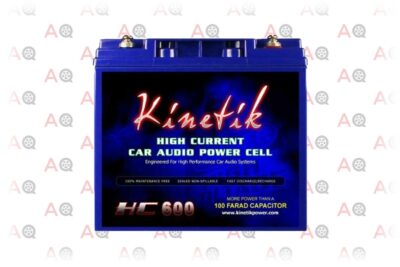
Editor’s Rating:
Quick Facts:
- Amperage: 600
- Type: AGM
- Terminal Types: M6 Threaded Insert
- Size: 7.13″x3.01″x6.57″
What Is It Best For?
Unless you want to pay a premium and get into the world of lithium, a small AGM battery like this Kinetik Black is the best way to fill in for the primary battery when it can’t keep up. It won’t run an entire 2000w system, but it will stop the headlights from dimming when your new 500w monoblock is turned up.
Our Review
This Kinetik battery is a great budget battery. It’s not the cheapest battery on our list: that honor belongs to the Mighty Max Viper. But it is the best combination of low price and high quality. It’s backed up by a 1-year warranty and includes high-quality brass lugs to make hooking it up easy.
The only issues with this Kinetik are issues that plague all secondary batteries. You have to do a lot more work to install them vs. replacing your primary battery.
Pros
- Small in size
- Terminals are good quality
- Inexpensive
Cons
- Needs more work to install
- Not enough power for big systems
3. Most Durable Car Audio Battery: Optima 8014-045 Yellow Top

Editor’s Rating:
Quick Facts:
- Amperage: 750
- Type: AGM
- Terminal Types: SAE and Side Post
- Size: Group 34 (10”x6.88”x7.63”)
What Is It Best For?
Optima makes batteries that are primarily geared towards heavy-duty applications. Racecars, off-road vehicles, and work trucks are the most common places to find Optima batteries in the wild.
That makes them perfect if you want to run a good amp and drive your vehicle hard. Unfortunately, this Optima doesn’t have the amps that a dedicated car audio battery like the XS Power battery has.
You won’t be running multiple amps and subs without adding a secondary. Still, it probably produces more power than your factory battery. If all you need is a bit more juice, here you go.
Our Review
Out of all the primary batteries we recommend, the Optima is the easiest to install and the one most likely to survive long term abuse. Unlike the Odyssey battery, which only has SAE posts, the Optima will easily fit into any vehicle regardless of cable type.
They are expensive for the amount of power you get, though. You are paying extra for the neat design and Optima sticker, so if you don’t plan on needing the extra strength, you won’t really benefit from this upgrade. If, however, you live in an extreme climate or plan on taking your car to the track while blasting tunes, you will be happy with it.
Pros
- Very durable
- Easy to install
- Has both SAE and Side Post terminals
Cons
- A bit expensive for the amount of amps
- Not enough amperage to run a big audio system
4. Best Entry Level Audio Battery: Mighty Max Battery Viper

Editor’s Rating:
Quick Facts:
- Amperage: 600
- Type: AGM
- Terminal Types: M6 Threaded Insert
- Size: 7.2”x2.99”x6.5”
What Is It Best For?
This is the best battery for someone to buy if they are just getting into large audio systems. It’s inexpensive enough that if you accidentally short it out and it blows up, you aren’t emptying your bank account to replace it.
It won’t replace your primary battery, but you can buy two of them for the cost of one XS battery that’s a similar size. That means you can chain a few together and get even more amperage for the same price, and you can run large systems that way. Just be aware that it’s more complicated to do that, and you run the very real risk of hurting your entire electrical system if you install them wrong.
Our Review
There are two batteries on our list that compare to the Mighty Max in terms of physical size and output. Both are more expensive. The XS Power option is a lot more expensive, but it produces 150 more amps. The Kinetik Black is only a little more expensive but is a bit higher quality.
That makes the best part about the Mighty Max battery the price. People who are just entering into the audio world or are on a tight budget will really appreciate the simple form factor in addition to the low price. If you have a bigger audio system or need a battery you can absolutely trust, then it would be better to look elsewhere.
Pros
- Very inexpensive
- Simple and easy to work with
- Small in size
Cons
- Quality is lower than similar batteries
- Amperage is a little on the low side
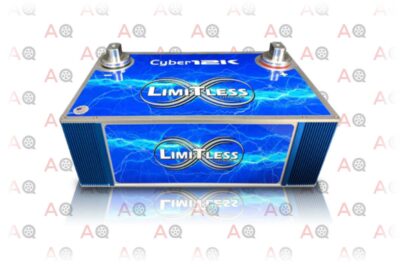
Editor’s Rating:
Quick Facts:
- Amperage: 12000
- Type: Lithium
- Terminal Types: M6/SAE Hybrid with Proprietary Busses
- Size: 13.5″x8″x6.25″
What Is It Best For?
This battery is best for hardcore car audio enthusiasts. The price puts it well outside of the budget for all but the most dedicated builders, and there are very few systems that can take advantage of 12k amps.
If you can, though, this battery is outstanding. Everything about it is designed for eardrum shattering. It’s lithium, so despite being about the same size physically as the XS Power Group 34 battery, it weighs a lot less. It’s got special terminals that can accept a large variety of hookups. It’s encased in its own heatsink. It’s awesome.
Our Review
When the energy of your secondary battery exceeds that of your primary, people know you mean business. It’s huge, can power serious amps, and even looks hardcore.
It’s really expensive, though. That expense extends beyond the price of the unit. Unlike a smaller AGM battery like the Kinitek, the lithium batteries need their own charge controllers. They need bigger wires to handle the power and a lot more planning when it comes to components. This battery is about as far away as you can get from an easy upgrade.
For the few that are ready for this level of power, it’s a must-have accessory.
Pros
- Huge amount of power
- Built to integrate with large systems
- Weighs less than half an equivalent AGM cell
Cons
- Really expensive
- Not for newbies
6. Best Small Audio Battery: XS Power XP750
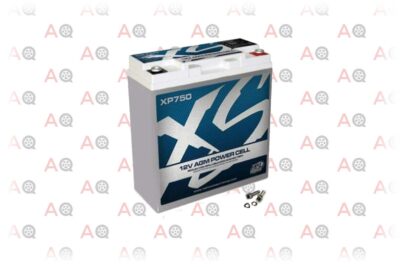
Editor’s Rating:
Quick Facts:
- Amperage: 750
- Type: AGM
- Terminal Types: M6 Threaded Insert
- Size: 7.13”x3.03”x6.57”
What Is It Best For?
If you are space-constrained, this is one of the best secondary batteries you can get. It’s the same size as the Kinetik Black Power Cell, but it is rated at 150 amps more.
The XP750 is likely the final step before switching to a much larger primary battery. The cost is high, but it doesn’t produce the amps for a monster system. You could buy two of the Kinetik batteries, have nearly twice the amperage, and after cables and fuses, you’d have spent about the same.
Or, you could upgrade to the full-size XS Power and get more than triple the power. Compared to most audio equipment, it’s still a great deal price-wise.
That leaves the people who have a modest system, need more power than a single standard AGM can give but don’t have the room for a larger battery. People who run two 10″ subs in their Miata rejoice.
Our Review
There’s not a lot to say about this battery. It’s XS Power, so it’s high quality, and it’s really got a lot of juice for the size. The only downside is that it is expensive, and despite having a lot of power, it’s still not even close to the dedicated primaries on our list.
Pros
- High-quality
- Great amperage rating for the size
- Small in size
Cons
- A bit expensive
- You might still need more power
7. Longest Lasting Audio Battery: Odyssey 34R-PC1500

Editor’s Rating:
Quick Facts:
- Amperage: 1500 Max with 850 CCA
- Type: AGM
- Terminal Types: SAE
- Size: Group 34R (10”x6.88”x7.63”)
What Is It Best For?
This battery only has about 850 amps to work with, so it’s not good for big audio systems. In fact, as a primary battery, it’s really not even big enough to run a moderately sized 1000w system. It’s 50lbs and takes up a lot of space, so it’s really not good as a secondary either.
What it is good for is anyone that has modernized their older car. A modern, modest infotainment system can easily demand 700 amps. Even in the early 2000s, cars didn’t come with factory batteries that big. That makes this a perfect drag and drop replacement battery for when you throw a new touchscreen head and 5-channel amp into your JDM superstar.
Our Review
We have a few batteries that are suitable for being your car’s primary battery on our list. They all cost about the same, and they are all the same size (Group 34.) They vary in a few ways that make them better suited for different situations, though.
The Optima is meant to be abused. You have a truck or offroader that needs a little more amperage to run the new subs you installed? The Optima is perfect.
The XS Power is all about getting the most amperage. It can handle 3000w systems, no problem. The Odyssey is the battery you buy if you don’t need a ton of amperage, and you just don’t want to have to worry about your battery. It is a very stable battery, which is good for sensitive electronics. It also charges faster and lasts longer than any conventional flooded lead-acid battery.
The one thing to note is that this particular battery is in group 34R, not the standard 34. That just means the positive and negative terminals are swapped around. If you currently have room for a group 34 but have short cables, you may want to search for the standard 34 instead.
Pros
- Very stable power output
- Maintenance-free
- Easy to install
Cons
- Amperage is a little low for an audio battery
- Heavy
8. Best Compact Lithium Audio Battery: MMG YTZ14S

Editor’s Rating:
Quick Facts:
- Amperage: 300
- Type: Lithium
- Terminal Types: J-Bolt
- Size: 6”x4”x5”
What Is It Best For?
This little lithium battery is primarily for motorcycles, but with a little bit of extra DIY, it makes an absolutely perfect secondary battery on a system built to be lightweight. It’s also perfect for all the people out there that install a sound system on their motorcycles or side-by-sides.
The biggest advantage that moving to a lithium battery has is that they are super lightweight. The Kinetik battery that we have on our list is about the same size physically. It weighs about 12 pounds. This MMG battery weighs 2 pounds. If you’ve ever worked with heavy AGM batteries, you know how much of a pain they can be to move around and how badly they get damaged if you drop them. All those problems are gone when the entire thing only weighs 2 pounds.
You are only getting about 300 amps, though, which is perfect for a small, lightweight system. Anything more than a 250w amplifier will really stress it, though, and there are not many car systems that are both low wattage and an upgrade from the factory.
Our Review
Let us be a little blunt. This battery is probably not the battery most people want. It has very low power for the size, is expensive for the size, and it requires some extra work to make sure your alternator will put out very consistent voltage.
However, there is a perfect reason to buy this battery and use it as a secondary battery, and one very good reason to use it as a primary. First, as a primary battery, it’s an excellent lightweight performance option. If you have something like a quad with speakers or an amp on a two-wheeled cruiser, it’s perfect.
As a secondary, it’s a great way to get into the world of lithium batteries. Basically, all the same reasons you’d buy the Mighty Max Viper apply to this MMG. If you want to run crazy experiments but don’t want to waste all of your spending money if something goes wrong, this is your best bet.
Pros
- Inexpensive for a lithium battery
- Very lightweight
- A good battery for experimenting with
Cons
- It’s fairly low power
- Expensive compared to an AGM of similar size
9. Best Secondary Audio Battery: Stinger SPP1200
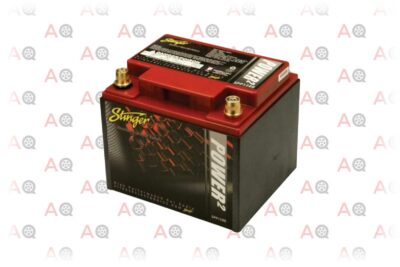
Editor’s Rating:
Quick Facts:
- Amperage: 1200
- Type: AGM
- Terminal Types: SAE Caps over Threaded Studs
- Size: Group 34 (10”x6.88”x7.63”)
What Is It Best For?
You could use this battery as a primary battery, but honestly, batteries like the XS Power 3400 are better for that function. What the Stinger SPP is perfect for is as a secondary battery for a fairly high-powered system.
It’s got a steel case so it can be banged up in the trunk of your car, and it’s a dry cell so you can mount it in any direction. All that leads to a very easy to work with, high capacity secondary.
Our Review
If your average car battery is a gas station cash register in terms of strength, and the super durable Optima battery is a bank vault, then the Stinger is Fort Knox.
It’s that level of quality. Not only does it have a steel case instead of a plastic case, it also has specialized internals that will allow it to keep functioning even if it’s punctured.
The Stinger is also an excellent value. It’s about the same price as the Odyssey and only a bit lower output. The big difference is that the Odyssey battery makes a great primary battery, but the Stinger doesn’t. The 1200 amps are optimistic; the reality is that it’s closer to 500 CCA with the occasional 1100 amp peak.
That’s still a lot of juice, and this battery is still a fantastic secondary. As long as you have the room for a big unit like this, you’ll be happy.
Pros
- Very high-quality
- Has a metal case
- Decent amount of power for a secondary
Cons
- Big for a secondary
- The steel case makes it extra heavy
10. Best Audio Battery Alternative: Pyle 5.0 Farad Digital Power Capacitor
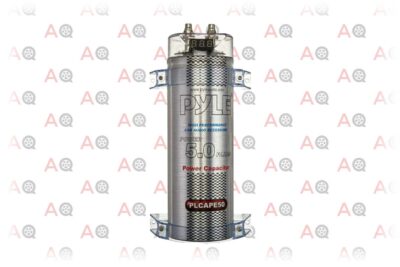
Editor’s Rating:
Quick Facts:
- Amperage: Up to +500
- Type: Capacitor
- Terminal Types: Posts
- Size: 3.5” Diameter, 9” Tall
What Is It Best For?
Capacitors and batteries seem really similar at first. They both charge up then release power. The big difference is that a battery is very slow, and a capacitor is very fast. As a very simplified example, a battery for a 500w system might take an hour to charge with a standard alternator. A capacitor will charge and discharge multiple times per second. The discrepancy is that big.
We included a capacitor on our list because they can be used to solve the same problems that a larger or secondary battery can solve. However, a capacitor is a lot easier to install than a secondary battery. They are usually much cheaper, and you will probably be installing one as you upgrade your system over time anyway. That means the answer to the question, “who is this device best for?” is “anyone that has a custom audio system in their car.”
Our Review
When it comes to problems with electricity, there are often multiple ways to solve the same issue. Take the issue of your headlights dimming because your battery doesn’t have enough power. The reason is your sound system is robbing your lights of the energy they need.
To solve that issue, you can greatly increase the amount of power you have available. That’s what adding an additional battery does. Or you could decrease the amount of energy the sound system needs to run. That’s what adding a capacitor does. It makes the amps more efficient so that they require less power to produce the same results.
Capacitors are not nearly as dramatic a change, though. This capacitor will work best if you have a mostly factory car with a moderate upgrade to the sound and notice some of the low power production symptoms. It will not have any effect if there is a considerable discrepancy between the battery power and the sound system requirements.
Pros
- An inexpensive solution to power problems
- You’ll need one for a large sound system eventually anyway
- Easy to install
Cons
- Not a replacement for a big battery for a big system
- Adds a layer of complication to a sound system
All About Audio Batteries
In this section, we’ll take a more detailed look at all the differences between battery formats, and we’ll give you some best practices for installing your own. First, though, we are going to talk about the most important parts of car audio electrical.
Alternators and the Big 3
A car’s electrical system consists of an alternator, a battery, and some wires. Typically, your battery is for starting the vehicle and running electronics when the engine is off. The alternator takes over for everything once the engine is running. When you introduce a considerable demand on the electrical from an extensive audio system, you can exceed the amount of power the alternator and battery can produce.
That means that the battery is only ⅓ of the problem if you are having a shortage of power. We’ll touch on the other two here, but this article has an excellent breakdown if you want to get more into it.
The Big 3
There are three main connections to the battery. There is a cable from the battery to the engine ground, a cable from the battery to the chassis ground, and a cable from the battery to the alternator. Upgrading these cables, called the big 3, is the first step in upgrading your electrical system. It can solve a lot of the issues related to low amperage and is a requirement for upgrading other electrical components.
The Alternator
An upgraded alternator is a must for any large audio system. Whenever you add more battery power or amperage demand, you will tax a factory alternator. An overtaxed alternator will fail, and when it fails, it can damage other components. Suppose you have power issues at low volumes while the motor is running, or you don’t plan to run the stereo with the engine off very often. In that case, an alternator is a better investment than a battery.
How Many Amps Will You Need?
This is a very complicated question, and the very frustrating answer is “it depends.” This article does a good job of breaking down all the different scenarios, but the gist is that you have to take time to find out how much power you are making currently, and subtract it from the amount of power you need. Then get a battery that exceeds that number.
The easiest way to quickly calculate the amount you need is the method we mentioned above. Simply add up the wattage of all your amps, and then make sure the amount of amps from the battery or batteries equals the wattage you need.
When in doubt, go bigger. A big battery won’t hurt a system; you’ll just be spending a little more than you need to.
Primary vs. Secondary
One of the things you have to keep in mind when making a decision on how many amps you need is that if you get a new, bigger primary batter, you will only be adding the difference in amperage between the old battery and the new one. For example, if you currently have a battery with a rating of 500 amps and install the 1150 amp Odyssey battery we recommended, you are only gaining 650 amps.
It would be a lot cheaper to get 600 amps by simply installing a smaller secondary battery, like the Kinetik here, since the entirety of the amperage from a secondary battery can be used to run the amplifiers.
The Types of Batteries
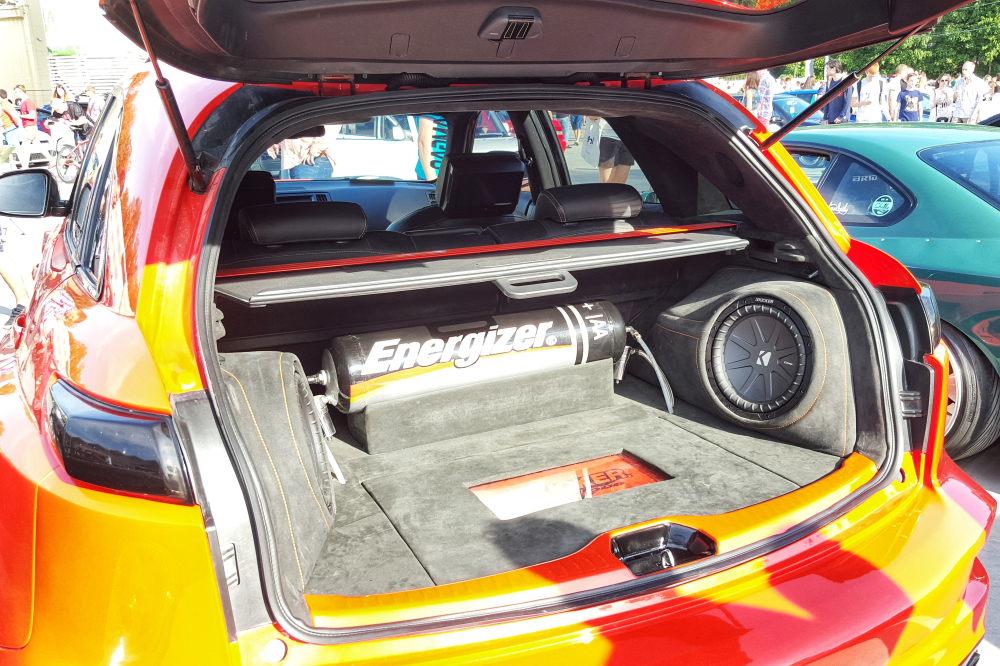
There are two main types of batteries in the car audio world you will come across: lithium and AGM. These batteries are deep cycle batteries, and they are maintenance-free. They differ from your standard car battery in a few important ways.
First, they are not fluid-filled, so they cannot spill out. They also don’t need to vent. That means you can place them anywhere, in any position, and not have to worry about them spilling out and dissolving your carpeting. Second, they can handle being run lower and charged faster. Running a large audio system will drain a battery frequently, and a standard battery will die much faster if it is discharged that often.
Lithium vs. AGM
Go Power is a company that usually deals with solar panels, but they have a really great write up on the differences between these two battery types. Though, the basics are that lithium batteries can handle a higher load, survive a lot longer, are a lot lighter, and can charge a lot faster.
That’s why the most powerful battery on our list is a lithium battery. They are just a lot more expensive, which makes them not worth it in many scenarios.
Fitment
One of the most significant considerations, especially when deciding between an upgraded primary or adding a secondary, is whether or not the battery will fit into your car. A secondary battery needs to be placed where it won’t get too beat up. It also needs cables with fuses running to it, and it needs to be adequately secured. They take up a lot of room, and if you are very space-conscious, it’s probably better just to upgrade your primary.
If you are upgrading your primary, pay attention to the terminal locations and styles. You can convert terminals with parts like the ones for sale here, but it’s best to know what you need before you order a battery. Having to make a run to the parts when you don’t have a battery in your car can be a very inconvenient experience.
Installing a New Battery
Here are some simple tips when installing a new battery.
- Always disconnect the primary negative cable before doing anything with car electrical.
- Install fuses as close to the battery as possible.
- Install capacitors and secondary batteries as close to the amplifiers as you can.
- Pay very close attention to the positive and negative terminals. Hooking a battery up in series instead of parallel will double your voltage instead of your amperage, and that will harm components. Hooking up a primary battery backward can outright destroy your entire system.
- Always make sure your grounds are clean and secure. A bad ground is one of the hardest issues to diagnose; it’s much easier to just do it right the first time.
- Double, then triple check all the bolts and connections. Especially terminal clamps and ground screws. Bolts can loosen over time, so anytime you mess with the electrical, it’s good to check.
Crank the Volume
There’s no end to the car audio customization journey. Understanding batteries is a huge step in making the ultimate sound system, especially since having car performance problems makes your car lame no matter how much bass you can crank out. Grab a new power cell and turn it up instead.
